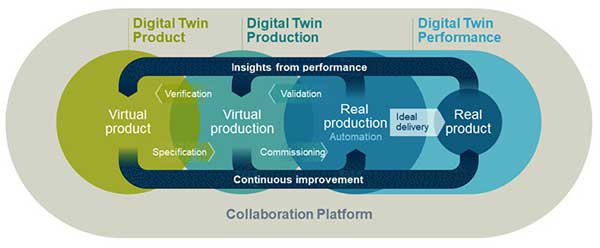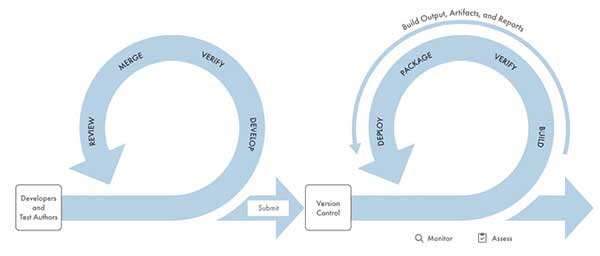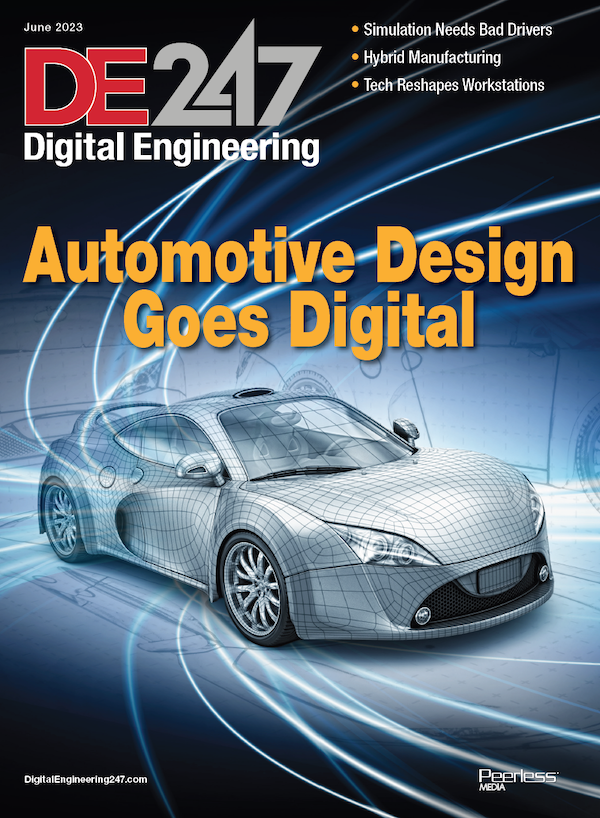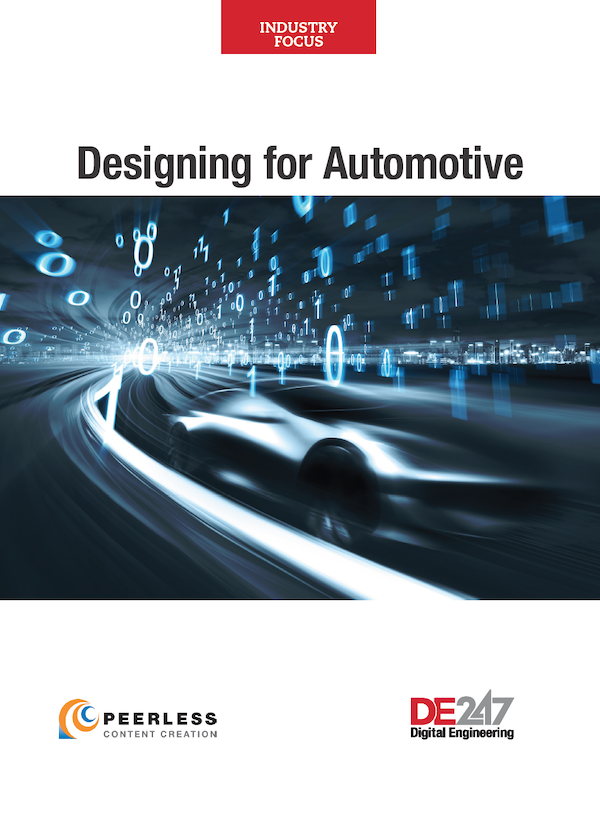
The connected car provides the perfect venue for digital thread and advanced software technologies to transform automotive design, development and refinement, ushering in what just may be a new automotive era. Image courtesy of Siemens Digital Industries Software.
Latest News
September 15, 2020
The vehicles rolling off of today’s automotive assembly lines may look like their predecessors, but delve deeper into their designs, and you will find a very different creation. This change lies in the convergence of advanced software, digital thread technologies, ubiquitous sensing and wireless communications—a perfect storm that aggregates all the ingredients required to produce the connected car.
What does this disruptive development mean for the automotive engineer? It introduces the need to adopt and adapt new development methodologies, tools and design concepts (Fig. 1).
But there’s a reason why analysts call metamorphoses like this “disruptive.” The market offers the engineer a raft of design tools, practices and philosophies. But at this stage, the challenge is finding the right combination. To successfully develop the connected car, design teams must reconcile an interesting clash of design cultures, problem-solving styles and ultimately visions of what a successful design looks like.
What’s Different?
Buyers have traditionally compared vehicles on their driving performance, and that likely will be the top consideration until autonomous vehicles become a reality. Various new factors, however, have emerged, in many ways paralleling developments in the consumer electronics market. These market forces are redefining consumer expectations and changing automotive value propositions.
One of these agents of change is the increasing value attributed to software-based functionality.
“Everything about automotive transportation is changing—the way we buy vehicles, the way we drive them, the way we get them serviced and updated and the way vehicles are integrated into our daily lives.”
“Software-based features and services are among the greatest differentiators of the connected car, and many of them will—in fact, they already are starting to—mimic those that have proven so popular on mobile devices,” says Pawel Chadzynski, senior director of product marketing at Aras. “The ultimate mimicking, however, will likely not be achieved through replication of the mobile platform features within the car’s software but through a much tighter integration of the mobile platform with the car’s infotainment platform through initiatives like Apple CarPlay and Android [Auto].”
Software-enabled infotainment features and services, however, are just the tip of the iceberg. Software now touches almost every aspect of the vehicle’s operation. In fact, most automotive functions today are software-controlled or managed, including critical subsystems like the powertrain, transmission and braking systems.
Add to the mix new connected-car safety features that interact with other vehicles and transportation infrastructures, and it becomes clear that software ultimately goes a long way toward defining tomorrow’s vehicles.
To appreciate the scale of software’s footprint, consider how much code goes into today’s cars. As far back as 2014, a typical car contained more than 100 million lines of code, and that number has since grown. By comparison, the Boeing 787 has around 14 million lines of code.
Beyond Reinventing Transportation
The disruption ushered in by the increasing role of software promises to fundamentally change the automotive era as we know it.
“Everything about automotive transportation is changing—the way we buy vehicles, the way we drive them, the way we get them serviced and updated and the way vehicles are integrated into our daily lives,” says Piyush Karkare, global director for automotive industry solutions, Siemens Digital Industries Software. “The only way for automotive [original equipment manufacturers (OEMs)] to maintain their profit margins is to reduce costs and provide rewarding customer-facing features. OEMs and suppliers alike have realized this can only be done by shifting more toward software-driven features and services and reducing or commoditizing hardware content.”
In Pursuit of Traceability
To meet the challenges of a disruption at this scale, engineers need comprehensive digital threads that tightly integrate both hardware and software development data sources. Thread development platforms must provide a window on all of the hardware-software interdependencies that make up the complex designs, throughout the vehicle’s lifecycle (Fig. 2).

“The platform must support explicit traceability of specific features from as-designed to the state of the car in the field,” says Chadzynski. “This is because manufacturing, maintenance, wear and tear, and customization of the car result in configurations that no longer represent the as-designed configuration.”
This approach provides automotive development teams with the holistic view required to see emergent properties that may cause catastrophic results. For example, the availability of a feature delivered by software as a service often depends on the presence of the appropriate hardware. There are times, however, when inclusion of the required hardware may be cost prohibitive for all product variants, and that must be considered in the overall system design.
Design engineers must realize that the ability to create differentiators and services through software directly relates to how software and hardware are designed. Thread development platforms must support coordinated co-design of the car’s software and hardware as a system.
Bridging the Software-Hardware Gap
One way to integrate hardware and software development processes throughout a product’s lifecycle is to blend product lifecycle management and application lifecycle management (ALM) platforms.
This approach promises to give software considerations equal footing with those of hardware, bringing the interdependencies between the two into sharper focus earlier in the design process. In addition, using this combination of tools aims to provide all members of development teams easy access to all product data throughout the lifecycle. This level of data transparency delivers a clear view of where defects are generated, where they are resolved and how to refine the development process.
Unlike standalone software developing tools, ALM platforms merge various engineering disciplines under one roof. In doing so, the platform can continuously manage the life of software from the initial concepts to its eventual retirement.
These platform features cover a broad spectrum of functional areas. These include such development phases as requirements management, planning, source code management and version control, testing, deployment, traceability, collaboration and application portfolio management.
Engineering software vendors generally sell ALM platforms as software suites made up of a number of specialized modules or components. The advantage of this architecture is that the platform incorporates the modules in a standardized environment that integrates data from a variety of systems and lifecycle stages, in an assortment of data formats.
Toward Agile Software Development
ALM platforms provide a systematic way of managing software throughout its lifecycle, but in an age of increasing customization and almost continuous software upgrades, this isn’t enough. The dynamic nature of the software requires development workflows capable of handling the ever-increasing speed and frequency of software delivery cycles.
An Agile workflow called continuous integration (CI)/continuous delivery (CD) aims to meet these challenges, with users combining these tools with the other modules under the ALM umbrella.
“We see organizations evolving their established model-based workflows by combining them with agile methodologies,” says Jim Tung, MathWorks fellow. “There is a focus on automating tasks, including simulations, regression test execution, code generation, document generation and so on (Fig. 3).”

CI calls for developers to integrate code into a shared repository several times a day. The process occurs after a “git push,” usually to a master branch. With each check-in, an automated process builds the application and runs tests to confirm that the newest code integrates with the software currently residing in the master branch. This helps the software engineers to more easily detect problems early in the development process.
CD then picks up where CI leaves off. These practices provide an automated process by which code changes are pushed to other infrastructure environments, such as development and testing.
CI/CD tools store environment-specific parameters that must be packaged with each delivery. Automation then makes the necessary service calls to databases, web servers or other services when applications are deployed.
Combined, the CI and CD processes facilitate collaboration and reduce time to market, enabling development teams to more quickly respond to customers’ needs. Furthermore, the automated pipelines created by these workflows reduce manual intervention, which promotes efficient use of development team resources.
Translating Data into Improved Performance
How do all these technologies and techniques enhance the connected car’s performance and drive design improvements in their engineering down the road?
For one, the increasing presence of software in the connected car provides engineers with a tremendous influx of valuable data. Properly managed via digital thread, this data gives engineers greater visibility of the vehicle’s behavior as it operates and interacts with humans and surrounding infrastructure.
This transparency allows engineers to rapidly verify and validate expected system behaviors in virtualized environments, based on real-world scenarios. Engineers can repeatedly execute scenarios, testing with a multitude of factors, such as glare, rain, fog, snow and sleet.
Development teams can also use data from real-world accidents and sensor models to further refine virtual testing and virtual hardware-in-loop simulation, where engineers can mask sensor input on a physical vehicle or system test with virtual scenarios.
This setup allows for rapid verification and validation cycles of changes to system behaviors before physical vehicles must be tested, further reducing the overall engineering costs and allowing for robust data-driven evidence for process and regulatory compliances.
From another perspective, the addition of vehicle communications capabilities opens the door for automakers to make near-real-time vehicle-performance improvements.
“A digital thread helps automakers proactively release over-the-air updates to address performance issues before warranty claims start cropping up,” says Greta Cutulenco, co-founder and CEO of Acerta Analytics. “They can even identify where the issue was introduced in the manufacturing process and address that in the next generation. Having visibility across the entire lifecycle of the vehicle means it won’t take years to figure out where something went wrong, and that significantly shortens development cycles.”
Raising the Bar on Maintenance
Another benefit of software’s growing presence and the emergence of digital thread is more informed vehicle maintenance. The level of service provided to connected car owners goes well beyond the maintenance experienced by previous generations of vehicle owners.
These improvements spring from an unprecedented level of visibility and accessibility, and they take the form of predictive maintenance.
“With digital thread, you know exactly what’s happening on your vehicles,” says Cutulenco.
Today, automakers can collect and analyze data from simulations and fleets of operational connected cars, determining the current state of a vehicle’s components and subsystems and how they have deteriorated over time. As a result, engineers can create effective predictive maintenance models based on data from different types of failures and associate those datasets with those failures.
“Connected-car data retrieval, well-designed data repositories and tools for building predictive maintenance models become the key technology combination,” says Tung. “With that in place, the ability to remotely retrieve information that indicates the history and current state of the vehicle, either at regular intervals or on demand, becomes the means for applying predictive maintenance.”
Although the flood of raw data stems from the extensive instrumentation of the connected car, the real powerhouse behind the increased visibility comes from off-vehicle software and this trend is only going to gain momentum.
There are already examples of this if you look closely under the hood. For instance, some drivetrains and chassis now monitor, collect and send data back to the cloud for analysis, recalibration and engineering updates, creating a feedback loop that improves the user’s experience. For instance, Tesla released an over-the-air update that improved performance and range by 10%.
Engineers can also use the data to infer the performance of components that aren’t instrumented. For example, you might not have sensors in your tires, but if you can detect suspension free play, you can also determine whether the tires are wearing out or need to be rotated. Combine this data with access to powerful off-vehicle analytics, and owners of connected cars can head off mechanical failures before they happen.
These maintenance enhancements, however, don’t stop there. Over-the-air software updates working with digital thread provide the overall traceability of changes, upgrades and service actions down to requirements, test cases and even lines of code.
This functionality also can be extended to monitor deployed software usage, to run analytics on issues and customer satisfaction factors, and to provide a closed-loop back to the as-designed phase to perpetually improve on feature and service offerings while reducing engineering costs.
Although the increased presence of onboard and off-vehicle software brings rich benefits, they also bring unique challenges.
“Given the many combinations of software and hardware configurations, which may or may not be compatible with a potential new function, digital thread data from integration test simulations are important for determining the configurations that would be a candidate for a particular over-the-air update,” says Tung.
An End of an Era?
The automotive era emerged about 120 years ago, replacing horses as the prime mode of transportation. Today, the forces shaping and leveraging the connected car may well prove to be the catalyst for the next sea change.
“We could very well be seeing that level of disruption causing the end of the automotive era as we know it,” says Siemens’ Karkare. “Automotive disruption in today’s automobile market is not about reinventing transportation, it’s about reinventing personal independence.”
More Aras Coverage
More MathWorks Coverage
More Siemens Digital Industries Software Coverage
Subscribe to our FREE magazine, FREE email newsletters or both!
Latest News






